Module Cycles
Use the Configuration tab in the Curriculum Manager module to manage teaching cycles. Cycles determine time periods for your curriculum to run, for example you may choose to set a cycle for each academic year.
The actual dates used within cycles are determined by the term dates linked to them.
- Open the Curriculum Manager and select the Configuration tab.
- Select Manage Module Cycles from the right hand menu:
- All cycles are listed here. Each cycle must be marked with a status to determine whether it is active, archived or being used in the future. Only one cycle can be marked as 'Active', 'Future' cycles are useful for planning cycles to be used in a future academic year.
- The information displayed in this screen for each cycle is determined by selections made in entity preferences.
- Use the drop-down in the top right of the screen to change the Group By setting if required. The selections available are determined by selections made in entity preferences.
- Use the navigation tools at the bottom of the screen to display the cycle that you want to work with.
-
Choose to:
- Add a module cycle.
- Rollover a module cycle. This is a useful shortcut for copying a cycle into another cycle. The rollover function also copies all previous data links.
- Update module entity preferences. Choose to change the entities displayed in the Manage Module Cycles screen.
- Copy a module cycle.
- Edit a module cycle.
- Delete a module cycle.
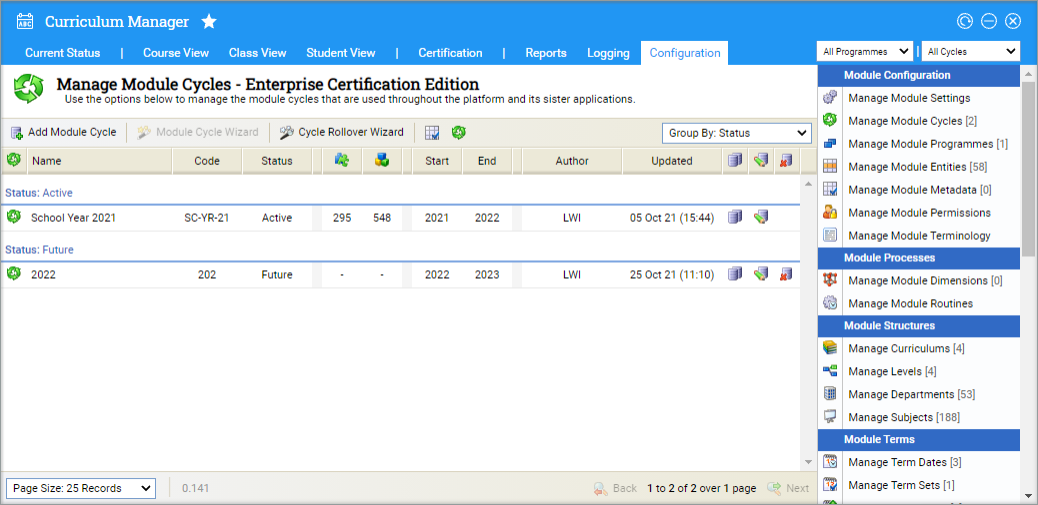
Add a cycle
- Select Add Module Cycle in the top left of the screen to display the Add Module Cycle window:
-
Complete the fields displayed:
Section Explanation Cycle Properties Enter a clear and concise name, code and description for the cycle. Cycle Options Use the drop downs to set the status of the cycle. Selecting 'Yes' for either of the options disables the drop-down for the other.
Only one cycle can be active at any one time. If you set this new cycle to be 'Active', any existing 'Active' cycle will be archived.
Cycle Timeframe - Set the Start and End Year for the cycle. The Start and End dates shown for each cycle are for display purposes only.
- Select a Graduation Year for the cycle.
- Select a timetable to link to the cycle. Timetables are configured in the Timetable Manager module. Linking here means that the timetable held in the Timetable Manager can be populated based on the data held in Curriculum Manager. Use of this field is optional.
- Select Save & Close. The cycle is displayed in the Manage Module Cycles screen.

Rollover a cycle
This is a useful shortcut for copying a cycle into another cycle. It performs the same function as copying a cycle, but offers less options to tailor the cycle details to suit you. All detailed of the rolled over cycle are duplicated.
The rollover function also copies all previous data links. So, rolling over a cycle from last year to this year enables the system to link terms from one year to the next, etc.
- Select Cycle Rollover Wizard in the header bar. A popup window is displayed:
- In the Copy From Cycle drop-down, select the cycle that you want to copy.
- In the Copy To Cycle drop-down, select where you want the cycle to be copied to. This must be a different cycle from the one the cycle is copied from.
- Select Save & Close. The cycle is rolled over as specified.
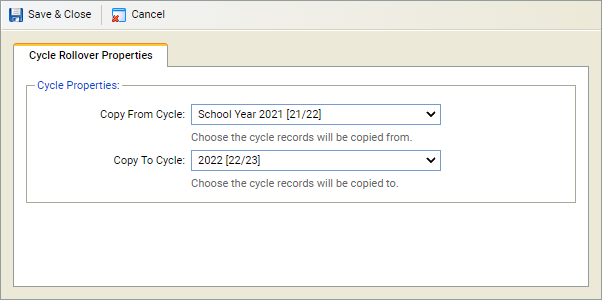
Update entity preferences
Update the entities displayed for cycles. For example, choose to display cycle Description in the Manage Module Cycles screen grid.
Your entity preferences can also be configured centrally from the Manage Module Entities option.
- Select the timetable icon in the header to display the Edit Module Entity window:
- The Entity Properties tab displays an overview of your entity preferences.
- The four following tabs hold property details for the entity. A count next to the tab title indicates the number of selections made in the tab.
- The Audit tab lists any amendments that have been made to the entity.
-
In the Entity Properties tab:
- Entity Properties cannot be changed.
- It is not recommended that you make any changes to Export & Import Options.
- Filter Options indicate the number of rows displayed if filters are used for the entity. The example below has 6 rows in the filter:

The Manage Module Cycles screen does not use filters, as indicated in the Entity Filters (0) tab, so this field is not applied in this case.
-
Work through the tabs shown to set details for the entity:
 Entity Fields
Entity Fields
All of the fields that are available for the entity are listed.
Change the Display Names for the fields as required:
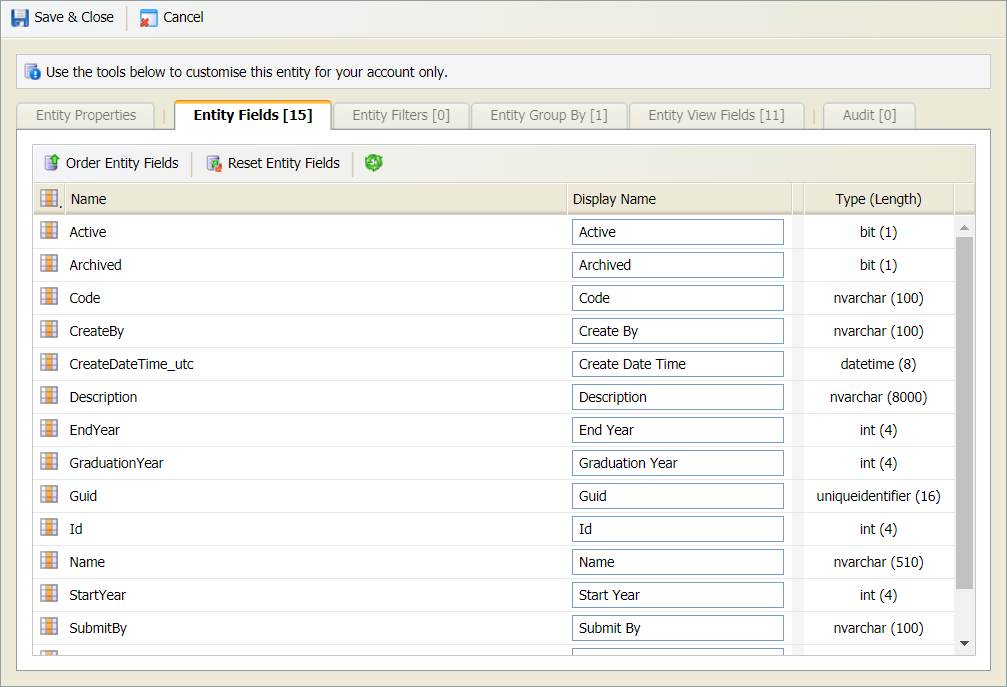
 Entity Filters
Entity Filters
The Entity Filters tab is not being used for cycles.
 Entity Group By
Entity Group By
All of the group by selections that can be made for the entity are listed.
- Use the checkboxes to select the group by selections that you want to include for the entity:
- Select a default if required.
-
Change the Labels and Titles as
required:
- The Label name is displayed in the Group By drop-down menu.
- The Title name is displayed in the screen where data is grouped. An example of how your selections are displayed for the selected entity is shown below:
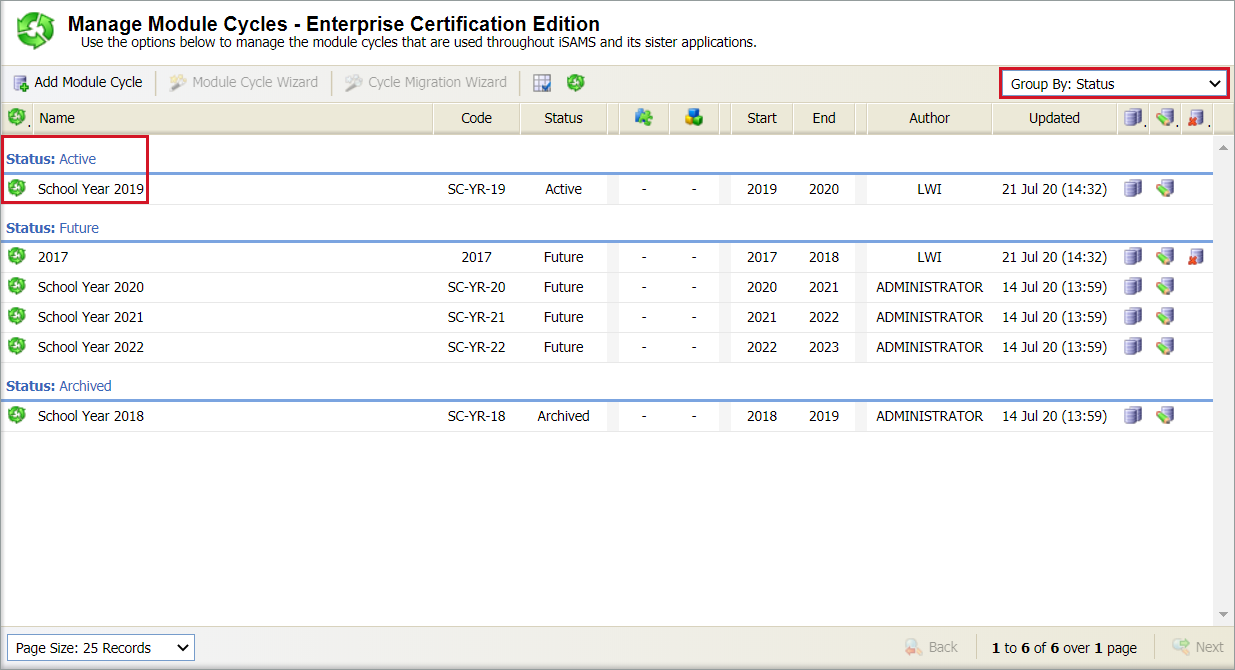

 Entity Views
Entity Views
All of the information that can viewed for the entity is listed.
- Select the Entity Views tab.
- Use the checkboxes on the left to select the columns that you want to display:
-
Select whether an Image or a Title
are displayed in the header bar for the entity. Either:
- Use the Select Image drop-down to select an image for the entity. An icon is used instead of a column title. or
- Enter a Title for the entity and check the box to the left of the Title. This is useful if you want to customise titles to suit you.
- Your selections determine the columns displayed for the selected entity:

Be aware that the selections made in Manage Module Settings can determine the fields that are displayed regardless of whether they are selected here.
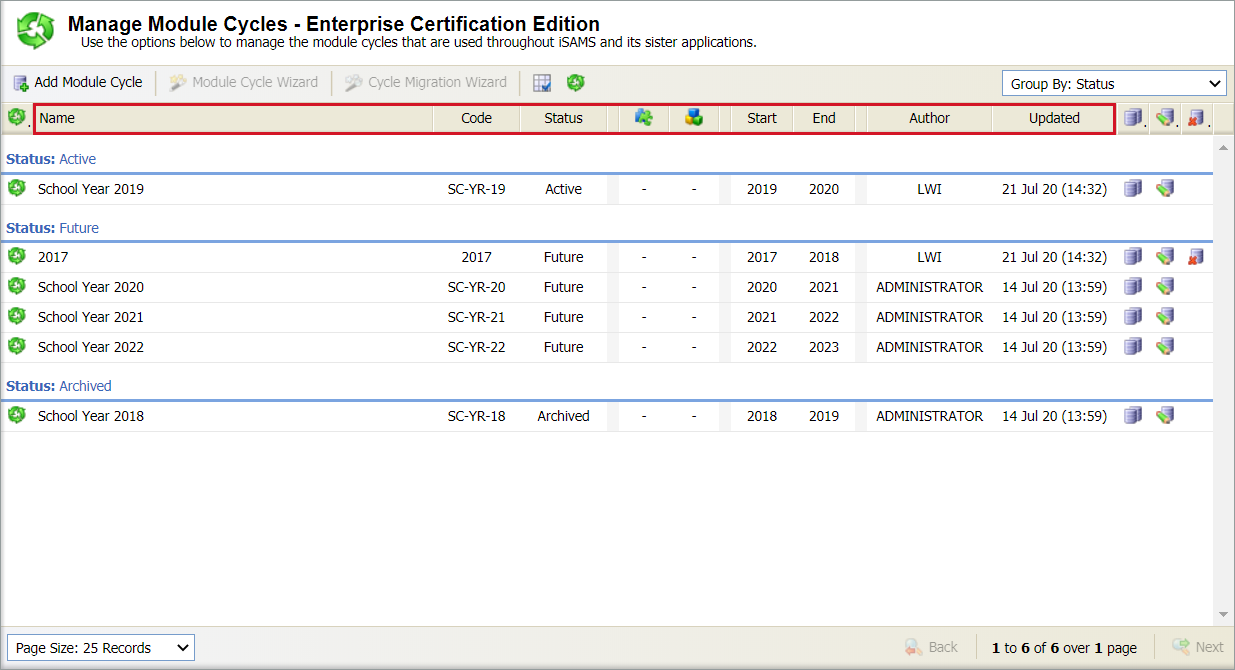
-
Choose to change the order that any of your entity selections are displayed
in the module.
- Select Order Entity xxx in your selected tab. A popup window is displayed, an example is shown below:
- Select to make a selection and use the arrows to move it up or down the list.
- Select Save & Close to close this window and return to the Edit Module Entity window.
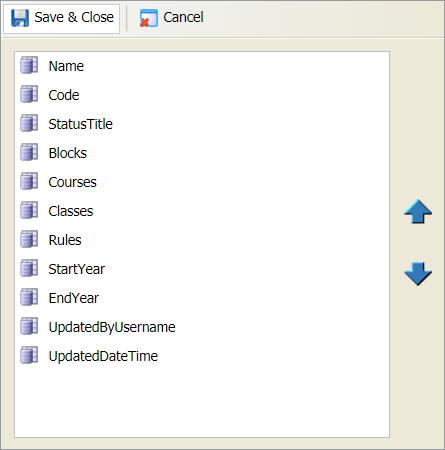
- Any changes made to entities are listed under the Audit tab in the window:
- Select Save & Close to close the Edit Module Entity window. Your preferences are displayed in the Manage Module Cycles screen.

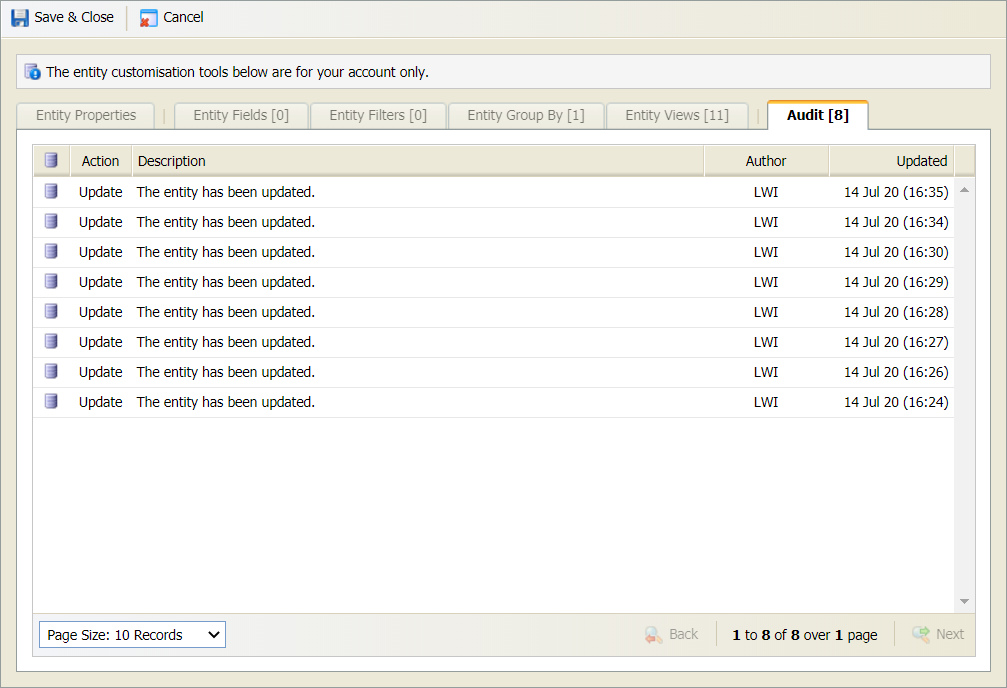
Copy a cycle
Choose to copy a module cycle. This is useful for recreating a cycle for a new time period.
- Scroll to the cycle that you want to copy and click the copy module cycle icon. A popup window is displayed:
-
Complete the fields displayed:
Section Explanation Cycle Properties Enter a clear and concise name, code and description for the cycle. Cycle Options Use the drop downs to set the status of the cycle. Selecting 'Yes' for either of the options disables the drop-down for the other.
Only one cycle can be active at any one time. If you set this new cycle to be 'Active', any existing 'Active' cycle will be archived.
Cycle Timeframe - Set the Start and End Year for the cycle. The Start and End dates shown for each cycle are for display purposes only.
- Select a Graduation Year for the cycle.
- Select a timetable to link to the cycle. Timetables are configured in the Timetable Manager module. When a class is updated in the timetable, the linked curriculum cycle is automatically updated. This field is optional.
- Select Save & Close. The cycle is displayed in the Manage Module Cycles screen.
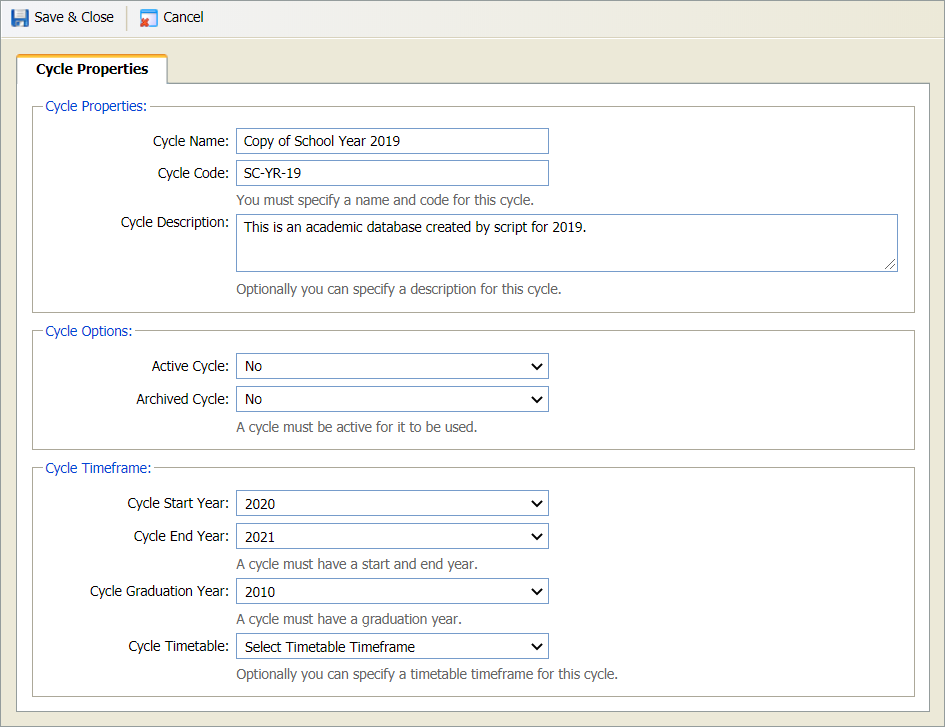
Edit a cycle
Update the details of a cycle if required. For example, change the status of a cycle currently marked as 'Future' to 'Active'.
- Scroll to the cycle that you want to edit and click the edit icon. The Edit Module Cycle window is displayed:
-
Update any fields that you want to edit:
Section Explanation Cycle Properties Enter a clear and concise name, code and description for the cycle. Cycle Options Use the drop downs to set the status of the cycle. Selecting 'Yes' for either of the options disables the drop-down for the other.
Only one cycle can be active at any one time. If you set this new cycle to be 'Active', any existing 'Active' cycle will be archived.
Cycle Timeframe - Set the Start and End Year for the cycle. The Start and End dates shown for each cycle are for display purposes only.
- Select a Graduation Year for the cycle.
- Select a timetable to link to the cycle. Timetables are configured in the Timetable Manager module. When a class is updated in the timetable, the linked curriculum cycle is automatically updated. This field is optional.
-
Three other tabs are available, these are explained as follows:
- Metadata. Any metadata fields set up for module cycles are listed here. Add values for the metadata fields as required.
- Child Entities. Shows a count of areas of the module linked to the selected cycle.
- Audit. Any changes made to the cycle are listed here.
- Select Save & Close.

Delete a cycle
Remove a cycle that has been added in error.
You cannot delete an active cycle or a cycle which contains data.
- Scroll to the cycle that you want to delete and click the delete icon. You are prompted Are you sure you want to delete this module cycle?
- Select Yes. The cycle is removed.
- A log is kept under the Logging tab for auditing purposes.